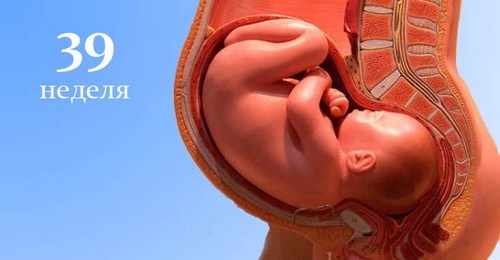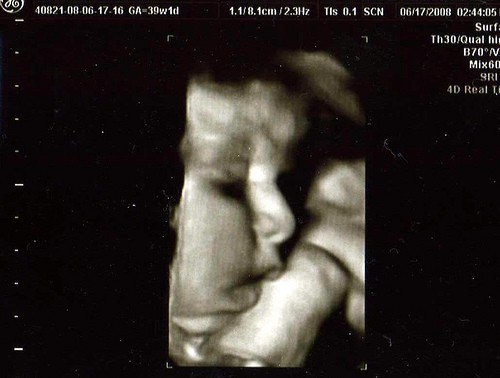The fetus at 39 weeks of gestation changed its position – pressed his chin to his knees. It continues to grow, but it becomes very uncomfortable and crowded to move.
All its internal organs are fully formed and already function as in an adult. The lungs are ready to open for the first breath.
At this stage, there is a danger that the umbilical cord, which nourishes the baby, may tie into a knot around his neck. But this situation is usually determined in advance by ultrasound.
Weight, height and size of the child
The size of the fetus at the thirty-ninth week of pregnancy resembles a small watermelon. The height of the baby is approximately equal to 50 cm. The weight of the baby at 39 weeks of gestation is about 3 kg. All these indicators, of course, may slightly differ in reality, which depends on heredity. The cannon (lagoon) has almost disappeared. Most toddlers have hairs on their heads.

How is the development of the baby
The development of the fetus at the 39th week of pregnancy is almost complete, the baby only gets the necessary fat and muscle mass. His skin has become more white and no longer translucent.
The digestive system is functioning. In the intestine, villi are formed, which already slowly move the original feces (meconium) into the lower sections. The glands of the stomach and pancreas work to the fullest. Enzymes are produced in the stomach that are needed to process incoming food. Now the digestive tract is completely sterile. Helping the digestion of bacteria, appear in the esophagus only with the first intake of breast milk.
At this stage, the child develops the main reflex – the sucking. When the baby is born and starts sucking milk, it will also form a chewing reflex. Only a month later, the salivary glands will begin to function in the newborn. To facilitate the sucking of milk in young children, special rollers on the mucous membrane of the lips are provided.
The rhythm of the baby’s life at 39 weeks of gestation is approximately the same as it will be immediately after birth. The baby already distinguishes sounds, reacts to light and feels the mother’s touch on the tummy. The baby’s gaze tries to focus, the eyes perceive a color image and react to the surrounding movement.
The central nervous system is not yet fully developed. She will continue to develop after the birth of the baby. At this stage, the spinal cord has matured, the facial nerves responsible for sucking, and the tissues responsible for protecting the nerves.
The condition of the future mother for a period of 39 weeks
The thirty-ninth week of pregnancy has arrived. You have gained about 12-16 kg. The weight gain this week is 300 grams, but from next week, most likely, there will be a tendency to slight weight loss.
The distance from the navel to the bottom of the uterus is 15-20 cm. At the moment, the fetus enters the birth canal, so the bottom of the uterus is reduced. Very soon, the first signs of childbirth will appear. In order to avoid aging of the placenta and lack of oxygen, it is necessary to visit the fresh air more often. Uterine pressure on the bladder causes discomfort. Listen to your condition and fights. You will certainly understand whether they are real or false when the time comes.
Unpleasant signs and symptoms at this time.
Symptoms at 39 weeks of pregnancy concern any expectant mother. The cervix begins to open. By the way, it has already become significantly shorter by this time. A very large burden is placed on the bladder. Often in women, due to frequent visits to the toilet, a depressive state occurs. May begin to stand out in colostrum from the nipples.
The fetus is now fully formed and is ready to get out of my mother’s house, because at this time the precursors of childbirth may well appear.
There are several signs:
- Frequent contractions with an equal period of time between them (more than 5 per hour);
- Abundant discharge appears, which indicates that the cork has departed or an amniotic bubble ruptured;
- It suddenly becomes much easier to breathe;
- There is a feeling of severe heaviness in the perineum;
- Diarrhea and possibly nausea begin to bother;
- Weight decreases sharply, on average, by 1 kg.
- Disturbing pulling back pain;
- Discharges with blood appear.
What can be the feeling
Thirty-ninth obstetric week of pregnancy is very tiring for a woman. All the movements of the child are very acutely felt. The added kilograms press on the bladder. The pressure on the pelvis increases, lower back pain intensifies, it becomes difficult to move around.
Harbingers of childbirth can develop into an acute form. Breathing exercises will help alleviate your serious condition. If the water has left, immediately go to the hospital. When the mucous plug closes the entrance to the uterus, an infection can get to the fetus.
It is necessary to pay attention to the nature of your vaginal discharge:
- in the form of pus and with an unpleasant odor – urgently need a doctor’s consultation and treatment;
- liquid and very plentiful – amniotic fluid has departed; urgently call an ambulance;
- with blood or a brown tint – the most dangerous discharge, they talk about placental abruption, putting your life with your baby at risk.
What weight gain depends on
In general, the total increase in kilograms directly depends on your physique. You can approximately calculate what the maximum allowable weight gain by the end of pregnancy can be based on the body mass index.

Body mass index is calculated as follows: your weight in kilograms must be divided by the height in meters squared. That is, with a weight before pregnancy of 60 kg and a height of 1.65 m, BMI is: 60 / (1.65 * 1.65) = 22.
Hence:
- Fragile women with an index of up to 19.9 – an increase of 14 kg;
- Normal physique with an index equal to 20-26 – increase – 13 kg;
- Large and overweight women with an index of more than 26 – an increase of 8.5 kg.
Thus, the smaller you are, the more kilograms you will be able to gain for the entire pregnancy. Accordingly, women in the body gain much less weight loss. It sometimes even happens that for a long time others are not aware of their interesting position.
The size of your big belly
What happens at 39 weeks of gestation with a stomach? It goes down, and every day lower. If the birth is not the first, then the abdomen falls almost before the birth itself. If the pregnancy is first, then this occurs in a few weeks or may not occur at all.
The kid has already begun to move less (about 12 times a day). With the correct presentation, its head is located in the area of your pelvis, the bottom of the uterus is tilted forward.
The abdomen in size seems too huge. The skin is stretched, perhaps a pigment strip appeared below the navel. In addition, the stomach itches and can peel off because the skin on it has lost its elasticity.
To alleviate your suffering in this regard, you can use special tools: creams, ointments and oils. Well, after childbirth, these symptoms will disappear on their own.
And so the tummies look at 39 weeks:

Important medical examinations and ultrasound
A gynecologist is needed to assess the condition of the baby and determine your readiness for the upcoming birth. As before, before each appointment it will be necessary to pass urine for analysis. The doctor will conduct the examinations already familiar to you in measuring weight, blood pressure, and the height of the bottom of the uterus. He listens with the help of a stethoscope to the baby’s heartbeat, and determines the position of the child in a probing way. Cardiotocography (CTG) and ultrasound are performed according to indications.
Ultrasound at the thirty-ninth week of pregnancy determines the location of the umbilical cord. She can wrap around the neck or body of the baby. This is not considered a global problem, since the umbilical cord is long (on average, about 60 cm, but it can also be short) and can be easily removed after birth. It is impossible to determine the length of the umbilical cord on an ultrasound scan. But thanks to ultrasound, the state of the placenta is assessed, the stage of its aging is determined.
Ultrasound also shows that the baby’s intestines expanded, it is gradually filled with meconium (original feces). In amniotic fluid, particles of skin and lubrication are observed.

What to do if labor begins
Delivery at 39 weeks of gestation is quite natural. The kid is completely ready to be born, he just needs a little help with this.
At the onset of labor, it is important to focus on proper breathing. Follow the doctor’s recommendations, as well as listen to your baby, monitor your body position and overall well-being.
During fights, it is better to walk rather than lie or sit. When contractions increase, you need to perform deep breaths and exhalations. This will help to save energy for attempts. You should start pushing only when the doctor starts. It’s better not to think about pain.
Do not panic, focus only on the baby. Immediately after birth, it will be applied to your breast so that it tastes milk for the first time and calms down after its first stress in life. This moment will be one of the most wonderful and unforgettable in your life!
Possible complications of pregnancy
At this time, the pregnant woman may have a depressive state associated with anxiety about the upcoming birth. There is fear and uncertainty that the birth will go well. Supporting loved ones will help ease nervous tension.
Possible deviations at 39 weeks of gestation include gestosis, fetal hypoxia, and premature placental abruption.
Our advice to expectant mothers
- All pregnant women in recent weeks are concerned about the issue of nutrition, because any day the birth can begin. Just try to eat right, eating only healthy foods. Do not overdo it and abuse food, because gaining weight now is completely useless. It is recommended to eat 5-7 times a day, but little by little;
- Take daily walks in the fresh air. So the baby will feel much more comfortable;
- If there is a slight malaise and fatigue, immediately try to lie down to rest;
- In a state of good spirits and good mood, you will be much more pleasant to survive the last days of pregnancy;
- It is important not to allow prolonged pain during movement, only slight tingling is acceptable. You must try to sleep and sit in comfortable poses. If the baby is pushing hard, it may mean that he is uncomfortable. In this case, you should change your position;
- In the last trimester of pregnancy, you get the last opportunity to calmly go with your husband to the children’s stores and buy something for the baby. Surely by joint efforts you will make a better choice than then your husband will go shopping for such things alone. By the way, shopping is also able to improve the mood, which is especially important for you now;
- Many are interested in the issue of sex in recent weeks. Listen to your body, because well-being is first and foremost. If you feel a strong attraction and crave affection, then why not. Scientists have proven that in the female body, hormones released during orgasm have an analgesic effect. And male secretion perfectly prepares the uterus for childbirth, making the cervix more elastic. But it is worth remembering that you need to have sex carefully, avoiding painful sensations.
This material is for informational purposes only, before using the information provided it is necessary to consult with a specialist.



